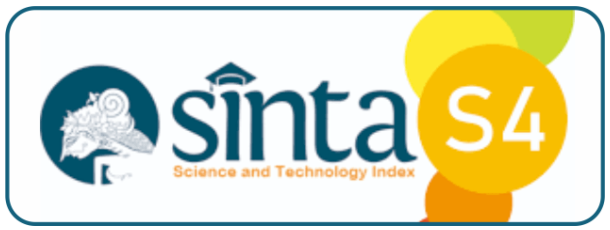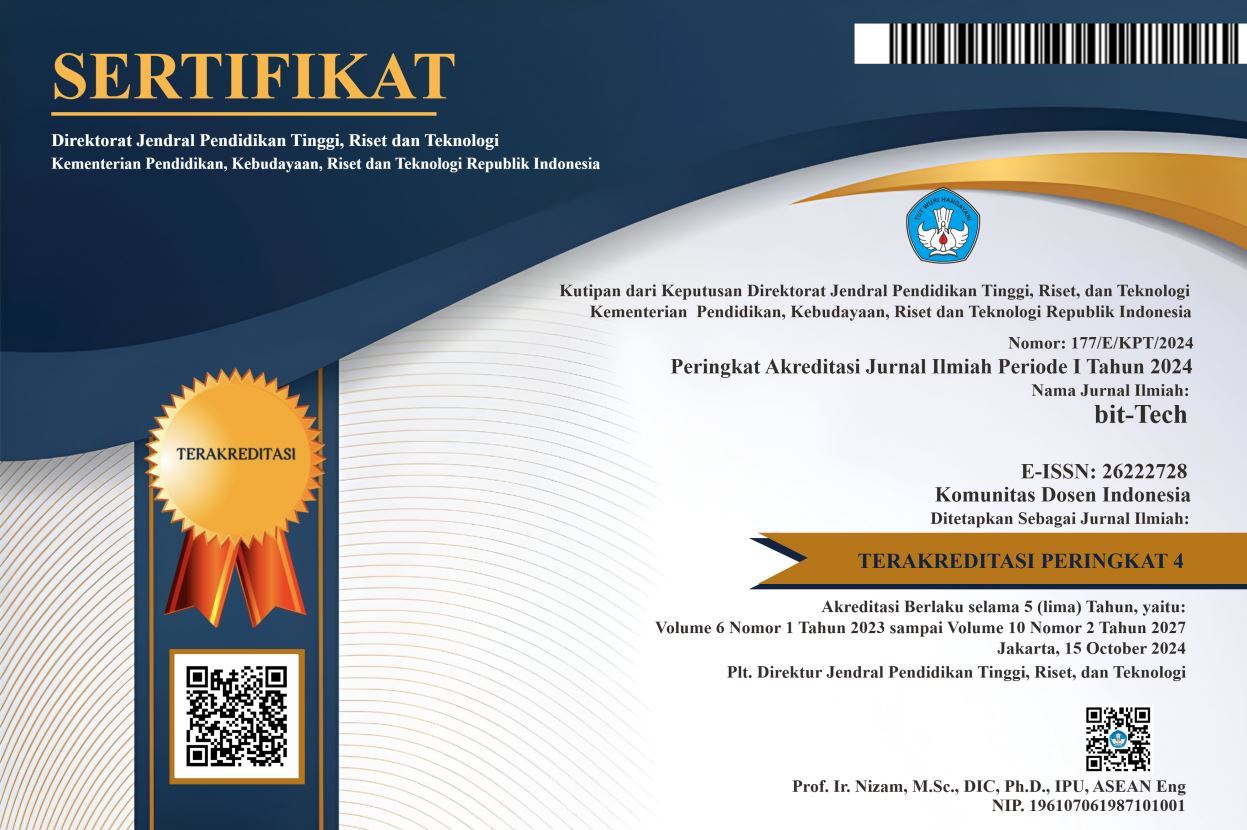The Use of Information Retrieval in Student Academic Document Plagiarism Detection System
DOI:
https://doi.org/10.32877/bt.v6i2.1063
Keywords:
Academic Documents, Detection System, Information Retrieval , Plagiarism, Turnitin
Abstract
The practice of plagiarism can threaten the credibility of academic documents such as final assignments, theses, theses, and dissertations. Universitas Muhammadiyah Ponorogo (UMPO) is one of the best Muhammadiyah Universities in Indonesia. All academic documents at UMPO are well stored. However, plagiarism is only found in the Turnitin database and in the title of academic documents. This research aims to pre-screen academic documents in the internal scope by creating a plagiarism application that is easy to use and cheaper in terms of cost than using Turnitin. The steps of making a plagiarism detection system in academic documents using information retrieval (IR) with waterfall development. The design process starts from system requirements analysis, design, implementation, and testing. This plagiarism detection system goes through several stages, namely tokenisation, stopword removal, stemming, and termweigthing. Tokenisation involves converting uppercase letters into lowercase letters and removing punctuation marks. Stopword removal removes noise, stemming converts words into basic forms, and termweigthing uses local and global weighting to calculate similarity with the Vector Space Model. Document similarity is calculated using cosine similarity, rejected documents are considered free of plagiarism. If there is no similarity, the document is accepted as a source document, while the rejected document is not stored in the database. Further research on the document plagiarism detection system that previously only used the txt file extension, in the future it can use the .doc or HTML extension so as to increase the effectiveness of the performance of academic document examination time.
Downloads
References
E. Bensal, E. Miraflores, and N. C. Tan, “Plagiarism: Shall we turn to Turnitin?,” CALL-EJ, vol. 14, pp. 2–22, Jan. 2013.
A. R. Fadilla, H. Haryadi, and M. Rapik, “Plagiarisme Karya Ilmiah Dalam Kacamata Hukum Pidana,” PAMPAS J. Crim. Law, vol. 4, no. 1, Art. no. 1, Feb. 2023, doi: 10.22437/pampas.v4i1.24074.
G. C. Adiyati and A. Supriyanto, “PENYEBAB DAN DAMPAK BAGI SESEORANG YANG MELAKUKAN TINDAKAN PLAGIARISME DALAM PENULISAN KARYA ILMIAH,” Semin. Nas. Arah Manaj. Sekol. Pada Masa Dan Pasca Pandemi Covid-19, no. 0, Art. no. 0, 2020, Accessed: Dec. 14, 2023. [Online]. Available: http://conference.um.ac.id/index.php/apfip/article/view/375
S. Wachidah, “PLAGIARISME DALAM KATA-KATA MAHASISWA: ANALISIS TEKS DENGAN PENDEKATAN FUNGSIONAL,” Linguist. Indones., vol. 31, no. 2, Art. no. 2, Aug. 2013, doi: 10.26499/li.v31i2.8.
T. Foltýnek, N. Meuschke, and B. Gipp, “Academic Plagiarism Detection: A Systematic Literature Review,” ACM Comput. Surv., vol. 52, no. 6, p. 112:1-112:42, Oct. 2019, doi: 10.1145/3345317.
L. Wulandari, “PENERAPAN TEXT MINING PADA SEARCH ENGINE (STUDI KASUS E-COMMERCE SHOPEE),” J. Teknol. Inf. Manaj. Dan Bisnis Digit., pp. 21–27, Sep. 2023.
N. Ahmad, A. A. Prasetyo, and A. Masruri, “PENERAPAN INFORMATION RETRIEVAL PADA SEARCH ENGINE,” Knowl. J. Inov. Has. Penelit. Dan Pengemb., vol. 1, no. 1, Art. no. 1, Dec. 2021.
F. Wiranto and I. M. Tirta, “Information Retrieval Using Matrix Methods,” presented at the International Conference on Mathematics, Geometry, Statistics, and Computation (IC-MaGeStiC 2021), Atlantis Press, Feb. 2022, pp. 167–172. doi: 10.2991/acsr.k.220202.032.
E. Fitriani, R. E. Indrajit, and R. Aryanti, “Penerapan Model Information Retrieval Untuk Pencarian Konten Pada Perpustakaan Digital,” J. Perspekt., vol. 15, no. 2, Art. no. 2, Sep. 2017, doi: 10.31294/jp.v15i2.2350.
A. Sutanti, M. K. Mz, M. Mustika, and P. Damayanti, “RANCANG BANGUN APLIKASI PERPUSTAKAAN KELILING MENGGUNAKAN PENDEKATAN TERSTRUKTUR,” Komputa J. Ilm. Komput. Dan Inform., vol. 9, no. 1, pp. 1–8, Mar. 2020, doi: 10.34010/komputa.v9i1.3718.
R. Nurmasari, S. Pinem, and U. Nurkhalifah, “Perancangan Pengelolaan Data Pelabuhan Perikanan Nusantara (PPN) Pelabuhan Ratu Menggunakan Entity Relationship Diagram (ERD),” J. Ilm. Rekayasa Dan Manaj. Sist. Inf., vol. 9, no. 1, Art. no. 1, Mar. 2023, doi: 10.24014/rmsi.v9i1.22024.
Z. Tuasamu et al., “Analisis Sistem Informasi Akuntansi Siklus Pendapatan Menggunakan DFD dan Flowchart Pada Bisnis Porobico,” J. Bisnis Dan Manaj. JURBISMAN, vol. 1, no. 2, Art. no. 2, May 2023, doi: 10.61930/jurbisman.v1i2.181.
N. Normah and F. Sihaloho, “Perancangan User Interface (UI) dan User Experince (UX) Aplikasi pendistribution alat-alat kesehatan pada perusahaan PT. Rekamileniumindo Selaras Jakarta Barat,” Indones. J. Softw. Eng. IJSE, vol. 9, no. 1, Art. no. 1, Jun. 2023, doi: 10.31294/ijse.v9i1.15467.
L. D. Krisnawati, J. F. Lim, and G. Virginia, “Penggunaan Pemodelan Topik dalam Sistem Temu Kembali Dokumen Termirip,” J. Linguist. Komputasional, vol. 6, no. 1, Art. no. 1, Apr. 2023, doi: 10.26418/jlk.v6i1.78.
R. Kaban, P. Sihombing, M. Pandia, and P. Simamora, “Pemrosesan Query dan Pemeringkatan Hasil dalam Information Retrieval: Sebuah Kajian Literatur,” J. Inf. Syst. Res. JOSH, vol. 4, no. 3, Art. no. 3, Apr. 2023, doi: 10.47065/josh.v4i3.2867.
Downloads
Published
How to Cite
Issue
Section
License
Copyright (c) 2023 bit-Tech : Binary Digital - Technology

This work is licensed under a Creative Commons Attribution-ShareAlike 4.0 International License.
I hereby assign and transfer to bit-Tech all exclusive copyright ownership rights to the above work. This includes, but is not limited to, the right to publish, republish, downgrade, distribute, transmit, sell, or use the work and other related materials worldwide, in whole, or in part, in all languages, in electronic, printed, or any other form of media, now known or hereafter developed and reserves the right to permit or license a third party to do any of the above. I understand that this exclusive right will belong to bit-Tech from the date the article is accepted for publication. I also understand that bit-Tech, as the copyright owner, has sole authority to license and permit reproduction of the article. I understand that, except for copyright, any other proprietary rights associated with the work (e.g. patents or other rights to any process or procedure) must be retained by the author. In addition, I understand that bit-Tech permits authors to use their papers in any way permitted by the applied Creative Commons license.


 DOI :
DOI :
 Abstract views: 106
/
Abstract views: 106
/  PDF downloads: 108
PDF downloads: 108











